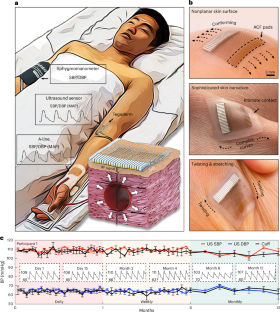2024-11-20 カリフォルニア大学サンディエゴ校(UCSD)
<関連情報>
- https://today.ucsd.edu/story/researchers-develop-clinically-validated-wearable-ultrasound-patch-for-continuous-blood-pressure-monitoring
- https://www.nature.com/articles/s41551-024-01279-3
- https://www.nature.com/articles/s41551-018-0287-x
血圧のの臨床的検証 Clinical validation of a wearable ultrasound sensor of blood pressure
Sai Zhou,Geonho Park,Katherine Longardner,Muyang Lin,Baiyan Qi,Xinyi Yang,Xiaoxiang Gao,Hao Huang,Xiangjun Chen,Yizhou Bian,Hongjie Hu,Ray S. Wu,Wentong Yue,Mohan Li,Chengchangfeng Lu,Ruotao Wang,Siyu Qin,Esra Tasali,Theodore Karrison,Isac Thomas,Benjamin Smarr,Erik B. Kistler,Belal Al Khiami,Irene Litvan & Sheng Xu
Nature Biomedical Engineering Published:20 November 2024
DOI:https://doi.org/10.1038/s41551-024-01279-3

Abstract
Options for the continuous and non-invasive monitoring of blood pressure are limited. Cuff-based sphygmomanometers are widely available, yet provide only discrete measurements. The clinical gold-standard approach for the continuous monitoring of blood pressure requires an arterial line, which is too invasive for routine use. Wearable ultrasound for the continuous and non-invasive monitoring of blood pressure promises to elevate the quality of patient care, yet the isolated sonographic windows in the most advanced prototypes can lead to inaccurate or error-prone measurements, and the safety and performance of these devices have not been thoroughly evaluated. Here we describe validation studies, conducted during daily activities at home, in the outpatient clinic, in the cardiac catheterization laboratory and in the intensive care unit, of the safety and performance of a wearable ultrasound sensor for blood pressure monitoring. The sensor has closely connected sonographic windows and a backing layer that improves the sensor’s accuracy and reliability to meet the highest requirements of clinical standards. The validation results support the clinical use of the sensor.
コンフォーマル超音波デバイスによる中心血圧波形のモニタリング Monitoring of the central blood pressure waveform via a conformal ultrasonic device
Chonghe Wang,Xiaoshi Li,Hongjie Hu,Lin Zhang,Zhenlong Huang,Muyang Lin,Zhuorui Zhang,Zhenan Yin,Brady Huang,Hua Gong,Shubha Bhaskaran,Yue Gu,Mitsutoshi Makihata,Yuxuan Guo,Yusheng Lei,Yimu Chen,Chunfeng Wang,Yang Li,Tianjiao Zhang,Zeyu Chen,Albert P. Pisano,Liangfang Zhang,Qifa Zhou &Sheng Xu
Nature Biomedical Engineering Published:11 September 2018
DOI:https://doi.org/10.1038/s41551-018-0287-x

Abstract
Continuous monitoring of the central blood pressure waveform from deeply embedded vessels such as the carotid artery and jugular vein has clinical value for the prediction of all-cause cardiovascular mortality. However, existing non-invasive approaches, including photoplethysmography and tonometry, only enable access to the superficial peripheral vasculature. Although current ultrasonic technologies allow non-invasive deep tissue observation, unstable coupling with the tissue surface resulting from the bulkiness and rigidity of conventional ultrasound probes introduces usability constraints. Here, we describe the design and operation of an ultrasonic device that is conformal to the skin and capable of capturing blood pressure waveforms at deeply embedded arterial and venous sites. The wearable device is ultrathin (240 μm) and stretchable (with strains up to 60%), and enables the non-invasive, continuous and accurate monitoring of cardiovascular events from multiple body locations, which should facilitate its use in a variety of clinical environments.


